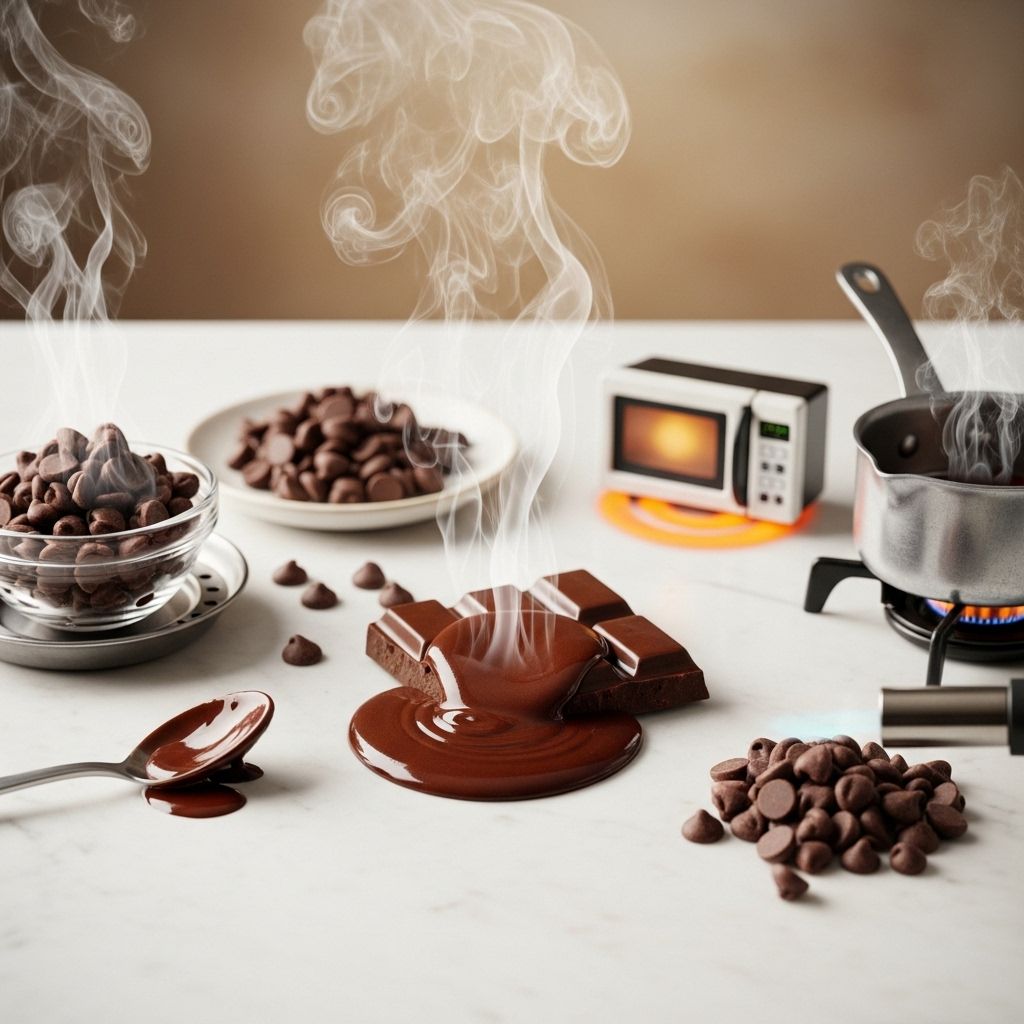The Art of Melting Chocolate
Unlock velvety textures for your desserts with precise heating and stirring techniques.

Introduction to Melting Chocolate
Melting chocolate is a fundamental skill in baking and cooking, essential for creating a variety of desserts and treats. Whether you’re making chocolate bark, decorating cakes, or crafting chocolate curls, the method you use to melt the chocolate can make all the difference between a smooth, even finish and a grainy, separated mess.
## Methods for Melting Chocolate
There are several ways to melt chocolate, each with its advantages and potential pitfalls.
1. Melting Chocolate in the Microwave
This is a quick and efficient method, ideal for small quantities of chocolate. To melt chocolate in the microwave:
–
Method:
Place the chocolate in a microwave-safe bowl. Heat in 30-second increments at regular power, stirring between each interval until the chocolate is fully melted.–
Pros:
– Fast
– Easy
– Minimal cleanup
–
Cons:
– Risk of overheating if not monitored closely
The microwave method is highly effective, requiring minimal effort and equipment. However, it does demand attention to avoid scorching the chocolate.
2. Using a Double Boiler
A traditional method that ensures gentle heating, ideal for larger quantities or when precision is crucial.
–
Method:
Fill a saucepan with about an inch of water and bring it to a simmer. Place a heatproof bowl over the saucepan, ensuring the bottom of the bowl does not touch the water.–
Pros:
– Gentle heat reduces the risk of scorching
– Suitable for larger quantities
–
Cons:
– Requires more time and equipment
This method is reliable but may take longer than microwaving. It’s crucial to monitor the heat and ensure the chocolate does not get too hot around the edges of the bowl.
3. Water Bath Method
Similar to a double boiler but uses residual heat after turning off the stove.
–
Method:
Place a bowl of chocolate into a skillet with about an inch of water. Bring the water to a simmer, then turn off the heat. The chocolate will melt using the residual heat.–
Pros:
– Gentle heat
– Easy to set up
–
Cons:
– May not be suitable for larger quantities
This method is efficient and gentle, reducing the risk of scorching. It’s a good option if you don’t have a suitable setup for a double boiler.
4. Melting Chocolate Directly in a Skillet or Saucepan
A risky method that requires close attention but can be effective.
–
Method:
Place the chocolate in a dry saucepan over low heat. Stir constantly to prevent scorching.–
Pros:
– Quick
–
Cons:
– High risk of scorching
– Not recommended for milk or white chocolate due to their lower melting points
While this method is quick, it’s risky and not recommended for less experienced cooks, especially with milk or white chocolate.
## Essential Tips for Melting Chocolate
–
Tempering:
For a smooth and glossy finish, tempring is essential. Tempering involves heating and cooling the chocolate to create a stable crystal structure.–
Stirring:
Always stir the chocolate between heating intervals to ensure even melting.–
Avoid Water:
Water can cause the chocolate to seize or become grainy. Ensure no moisture is introduced during the melting process.## Common Mistakes to Avoid
–
Overheating:
This can lead to a grainy or separated texture.–
Introducing Moisture:
Water will cause the chocolate to seize.–
Not Stirring:
Failing to stir can result in uneven heating and scorching.## Frequently Asked Questions (FAQs)
Q: Can I melt chocolate in a plastic bowl?
A: It is not recommended to melt chocolate in a plastic bowl, especially in the microwave, as it can cause chemicals to leach into the chocolate.
Q: How can I prevent chocolate from seizing?
A: Ensure that no moisture is introduced during the melting process, and avoid overheating.
Q: Can I reuse melted chocolate for other recipes?
A: Yes, melted chocolate can be reused in recipes, provided it has not been overheated or mixed with water.
Conclusion
Melting chocolate is an art that requires patience and practice. By understanding the different methods and their nuances, you can master the skill and create beautifully crafted chocolate treats. Whether you’re a beginner or an experienced baker, the right technique can elevate your recipes from ordinary to extraordinary.
References
- https://www.kingarthurbaking.com/blog/2023/02/08/how-to-melt-chocolate
- https://www.thepioneerwoman.com/food-cooking/recipes/a103908/how-to-make-chocolate-bark/
- https://www.youtube.com/watch?v=qLW3UTF9QzI
- https://www.thepioneerwoman.com/food-cooking/cooking-tips-tutorials/a8469/how-tomake-chocolate-curls/
Read full bio of Sneha Tete












